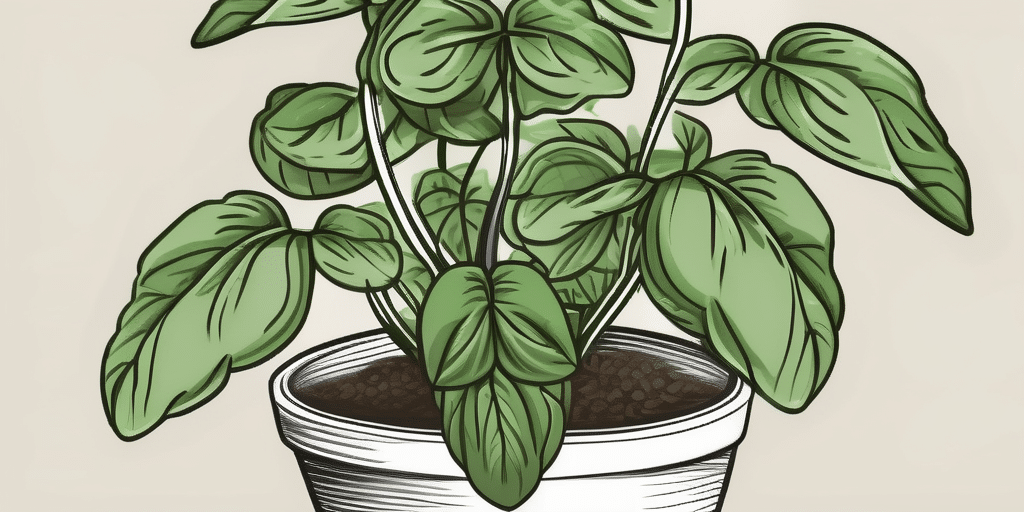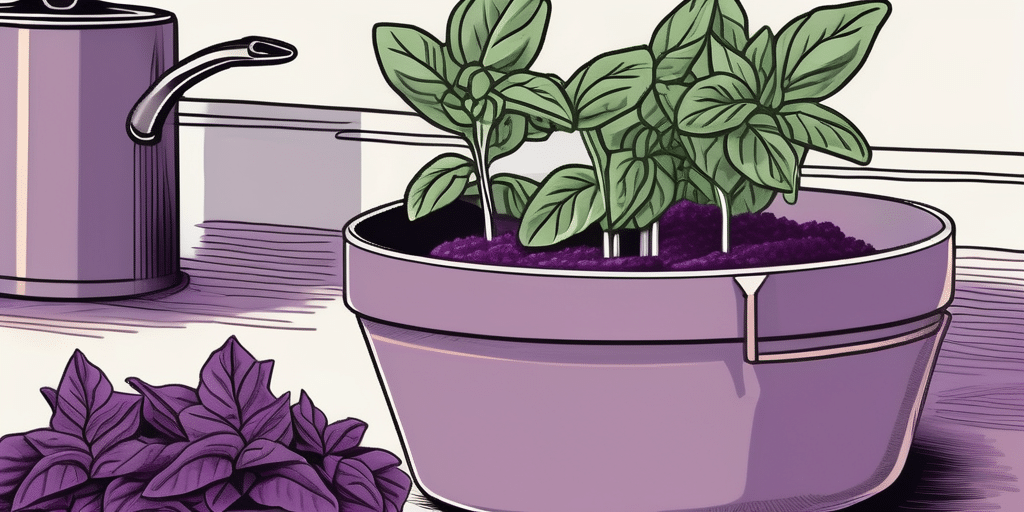Thai basil, also known as sweet basil or tropical basil, is a versatile culinary herb that adds a delightful flavor and aroma to a wide range of dishes. If you’ve always wanted to grow your own Thai basil at home, this comprehensive guide will provide you with all the information you need to successfully cultivate this herb and enjoy its wonderful benefits.
Understanding Thai Basil: An Overview
Before diving into the specifics of growing Thai basil, let’s take a moment to understand its unique characteristics and the nutritional benefits it offers.
Thai basil is a fascinating herb that stands out from its more common sweet basil counterpart. Its appearance and taste set it apart, making it a favorite among herb enthusiasts and culinary experts alike.
The Unique Characteristics of Thai Basil
Thai basil features a distinct purple stem and vibrant green leaves with a slightly serrated edge. These beautiful leaves add a touch of elegance to any garden or indoor herb collection. The plant itself grows to a height of about 12 to 18 inches, creating a lovely visual display.
One of the key differences between Thai basil and other basil varieties is its strong anise or licorice-like aroma. As you brush your fingers against the leaves, a delightful fragrance fills the air. This unique scent, combined with its peppery flavor, gives Thai basil its signature taste and makes it a popular ingredient in Thai, Vietnamese, and other Southeast Asian cuisines.
When you use Thai basil in your dishes, you not only enhance the flavor but also add an exotic touch that transports your taste buds to the vibrant streets of Thailand.
The Nutritional Benefits of Thai Basil
Beyond its delightful flavor, Thai basil also offers several nutritional benefits that make it a valuable addition to your diet.
Thai basil is rich in antioxidants, which help protect your body against free radicals and oxidative stress. These antioxidants contribute to overall health and well-being.
In addition to antioxidants, Thai basil is a good source of vitamins A and K. Vitamin A plays a crucial role in maintaining healthy vision and supporting a strong immune system. On the other hand, vitamin K is essential for blood clotting and bone health.
Thai basil also contains essential minerals like iron and calcium. Iron is vital for the production of red blood cells and the transportation of oxygen throughout the body. Calcium, on the other hand, is crucial for maintaining strong bones and teeth.
Moreover, Thai basil contains compounds that possess antimicrobial and anti-inflammatory properties. These properties may provide additional health benefits, such as fighting off harmful bacteria and reducing inflammation in the body.
So, not only does Thai basil add a burst of flavor to your dishes, but it also contributes to your overall well-being.
Preparing for Planting Thai Basil
Choosing the Right Location
When selecting a location to plant your Thai basil, ensure that it receives at least six hours of direct sunlight each day. Thai basil thrives in warm weather, making it ideal for gardens, balconies, or sunny windowsills.
Thai basil, also known as Ocimum basilicum var. thyrsiflora, is a popular herb in Southeast Asian cuisine. Its distinct flavor, which is a combination of sweet basil and licorice, adds a unique touch to various dishes, including curries, stir-fries, and soups.
Additionally, consider planting near other herbs, such as mint or lemongrass, to create a companion planting system that can help deter pests and enhance overall plant health. Mint, for example, releases a strong scent that repels insects, while lemongrass acts as a natural insect repellent.
Furthermore, Thai basil can also be grown indoors, allowing you to enjoy its fresh aroma and flavor year-round. Just make sure to place it near a sunny window or provide artificial grow lights to ensure it receives adequate light.
Understanding Soil Requirements
Thai basil prefers well-draining soil with a slightly acidic pH ranging between 6.0 and 7.5. You can achieve this by adding organic matter, such as compost or well-rotted manure, to improve soil structure and fertility.
Before planting, it’s a good idea to perform a soil test to determine its pH level and nutrient content. This will help you make any necessary amendments to create an optimal growing environment for your Thai basil.
In regions with heavy clay soil, you may want to consider growing Thai basil in containers or raised beds, ensuring proper drainage to prevent waterlogged soil. This will allow you to have more control over the soil conditions and ensure the plant’s roots don’t become waterlogged, which can lead to rot and other issues.
Remember to water your Thai basil regularly, keeping the soil evenly moist but not waterlogged. Overwatering can cause root rot, while underwatering can lead to wilting and poor growth. Finding the right balance is key to maintaining a healthy and thriving Thai basil plant.
The Planting Process
When to Plant Thai Basil
In most regions, Thai basil can be planted outdoors after the last frost date in spring. However, if you live in a colder climate, consider starting seeds indoors about six to eight weeks before the expected last frost to give your plants a head start.
Transplant the seedlings outdoors once the danger of frost has passed and the soil has warmed up to around 70°F. Thai basil thrives in temperatures ranging from 70°F to 90°F.
How to Plant Thai Basil Seeds
Start by preparing the soil by removing any weeds and loosening it with a garden fork or tiller. Sow the Thai basil seeds about 1/4 inch deep and cover them lightly with soil. Space the seeds approximately 6 to 12 inches apart, allowing enough room for the plants to grow.
Water the soil gently after planting the seeds, ensuring it is evenly moist but not saturated. Be patient, as Thai basil seeds typically germinate in about one to two weeks.
Caring for Your Thai Basil Plant
Watering and Feeding Thai Basil
Thai basil requires regular watering to keep the soil evenly moist, but avoid overwatering, as it can lead to root rot. Water the plant deeply whenever the top inch of soil feels dry. Applying mulch around your Thai basil plants can help retain moisture and discourage weed growth.
To promote healthy growth, feed your Thai basil with a balanced, water-soluble fertilizer every four to six weeks. Follow the instructions on the fertilizer package to determine the appropriate amount for your plants.
Pruning and Harvesting Thai Basil
Pruning Thai basil is essential for encouraging bushier growth and preventing it from flowering too early. Regularly pinch off the top one to two inches of the stems, just above a leaf node. This will stimulate lateral branching and result in a fuller plant.
You can begin harvesting Thai basil leaves when the plant has reached about six to eight inches in height. Simply snip off the leaves as needed, starting from the top, and avoid removing more than one-third of the plant at a time to ensure continuous growth.
Troubleshooting Common Problems
Dealing with Pests and Diseases
Thai basil is generally resistant to most pests and diseases. However, occasional encounters with aphids, spider mites, or fungal infections may occur. In the case of minor pest infestations, you can try removing them manually using a strong spray of water or introducing beneficial insects like ladybugs to naturally control the population.
If you notice signs of disease, such as wilting leaves or discoloration, promptly remove any affected plant parts to prevent further spread. Maintaining good air circulation by spacing your Thai basil plants adequately can also help minimize the risk of fungal diseases.
Overcoming Weather Challenges
In regions with extreme heat or intense sunlight, Thai basil may benefit from partial shade during the hottest part of the day. Implement shading strategies, such as using shade cloth or planting near taller plants, to provide relief from direct sun exposure.
If the temperature drops below 50°F, consider covering your Thai basil plants with a frost cloth or moving them indoors to protect them from cold damage. Remember to bring them back outside once the risk of frost has passed.
Now that you have all the necessary information, it’s time to start growing your own Thai basil! Whether you’re a novice gardener or an experienced herb enthusiast, with the proper care and attention, you’ll soon be rewarded with a bountiful harvest of fresh and aromatic Thai basil to enhance your culinary creations.

